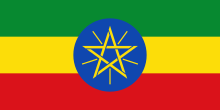Our website is made possible by displaying online advertisements to our visitors.
Please consider supporting us by disabling your ad blocker.
Water supply and sanitation in Ethiopia
 | |
| Data | |
|---|---|
| Water coverage (broad definition) | 38% (2008)[1] or 68.5% (2010),[2] depending on source and definition |
| Sanitation coverage (broad definition) | 12% (2008)[1] or 56% (2010),[3] depending on source and definition |
| Continuity of supply | Mostly intermittent |
| Average urban water use (L/person/day) | 30–60 (2006)[4] |
| Average urban water and sanitation tariff (US$/m3) | n/a |
| Share of household metering | Low |
| Annual investment in WSS | US$1/capita |
| Share of self-financing by utilities | Nil |
| Share of tax-financing | Low |
| Share of external financing | High |
| Institutions | |
| Decentralization to municipalities | Substantial, since 1995 |
| National water and sanitation company | None |
| Water and sanitation regulator | None |
| Responsibility for policy setting | Ministry of Water, Irrigation and Energy |
| Sector law | n/a |
| No. of urban service providers | n/a |
| No. of rural service providers | n/a |
Access to water supply and sanitation in Ethiopia is amongst the lowest in Sub-Saharan Africa and the entire world. While access has increased substantially with funding from foreign aid, much still remains to be done. Some factors inhibiting the achievement of these goals are the limited capacity of water bureaus in the country's nine regions, two city administrations and water desks in the 770 districts of Ethiopia (woredas); insufficient cost recovery for proper operation and maintenance; and different policies and procedures used by various donors, notwithstanding the Paris Declaration on Aid Effectiveness.
In 2001 the government adopted a water and sanitation strategy that called for more decentralized decision-making; promoting the involvement of all stakeholders, including the private sector; increasing levels of cost recovery; as well as integrating water supply, sanitation and hygiene promotion activities. Implementation of the policy apparently is uneven.
In 2005 the government announced highly ambitious targets to increase coverage in its Plan for Accelerated Sustained Development and to End Poverty (PASDEP) for 2010. The investment needed to achieve the goal is about US$300 million per year, compared to actual investments of US$39 million in 2001–2002. In 2010 the government presented the equally ambitious Growth and Transformation Plan (GTP) 2011–2015, which aims at increasing drinking water coverage, based on the government's definition, from 68.5% to 98.5%.[2] While donors have committed substantial funds to the sector, effectively spending the money and to ensure the proper operation and maintenance of infrastructure built with these funds remain a challenge.
- ^ a b Joint Monitoring Program for Water Supply and Sanitation:Ethiopia 2008 estimates Archived 2010-03-23 at the Wayback Machine, accessed on 18 September 2010
- ^ a b Ministry of Finance and Economic Development:Growth and Transformation Plan, Draft, September 2010, p. 18
- ^ Cite error: The named reference
WB resultswas invoked but never defined (see the help page). - ^ The International Benchmarking Network for Water and Sanitation Utilities (IBNET):Utility Search Archived 2010-03-01 at the Wayback Machine The range is for the five utilities serving Addis Abeba, Dire Dawa, Harar, Mekelle and Adama; accessed on September 19, 2010
Previous Page Next Page


